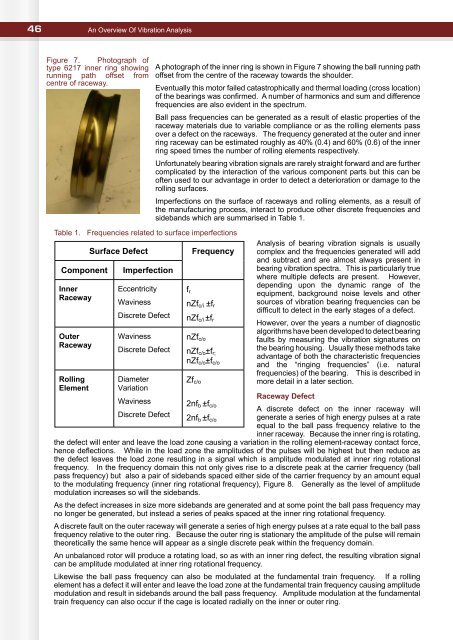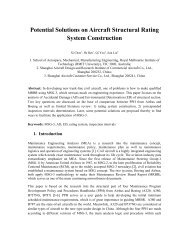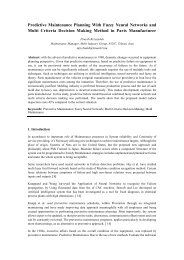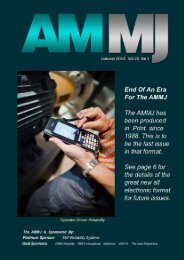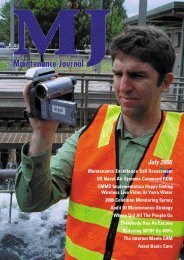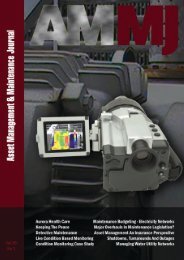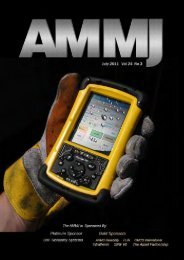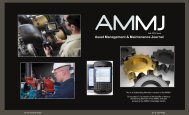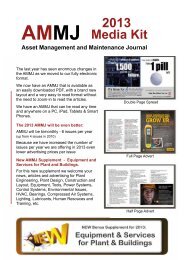DAY 1 - AMMJ
DAY 1 - AMMJ
DAY 1 - AMMJ
You also want an ePaper? Increase the reach of your titles
YUMPU automatically turns print PDFs into web optimized ePapers that Google loves.
46 An Overview Of Vibration AnalysisFigure 7. Photograph oftype 6217 inner ring showingrunning path offset fromcentre of raceway.A photograph of the inner ring is shown in Figure 7 showing the ball running pathoffset from the centre of the raceway towards the shoulder.Eventually this motor failed catastrophically and thermal loading (cross location)of the bearings was confirmed. A number of harmonics and sum and differencefrequencies are also evident in the spectrum.Ball pass frequencies can be generated as a result of elastic properties of theraceway materials due to variable compliance or as the rolling elements passover a defect on the raceways. The frequency generated at the outer and innerring raceway can be estimated roughly as 40% (0.4) and 60% (0.6) of the innerring speed times the number of rolling elements respectively.Unfortunately bearing vibration signals are rarely straight forward and are furthercomplicated by the interaction of the various component parts but this can beoften used to our advantage in order to detect a deterioration or damage to therolling surfaces.Imperfections on the surface of raceways and rolling elements, as a result ofthe manufacturing process, interact to produce other discrete frequencies andsidebands which are summarised in Table 1.Table 1. Frequencies related to surface imperfectionsComponentInnerRacewayOuterRacewayRollingElementSurface DefectImperfectionEccentricityWavinessDiscrete DefectWavinessDiscrete DefectDiameterVariationf rFrequencynZf c/i ±f rnZf c/i ±f rnZf c/onZf c/o ±f r;nZf c/o ±f c/oZf c/oAnalysis of bearing vibration signals is usuallycomplex and the frequencies generated will addand subtract and are almost always present inbearing vibration spectra. This is particularly truewhere multiple defects are present. However,depending upon the dynamic range of theequipment, background noise levels and othersources of vibration bearing frequencies can bedifficult to detect in the early stages of a defect.However, over the years a number of diagnosticalgorithms have been developed to detect bearingfaults by measuring the vibration signatures onthe bearing housing. Usually these methods takeadvantage of both the characteristic frequenciesand the “ringing frequencies” (i.e. naturalfrequencies) of the bearing. This is described inmore detail in a later section.Raceway DefectWaviness 2nf b ±f c/oA discrete defect on the inner raceway willDiscrete Defect2nf b ±f c/ogenerate a series of high energy pulses at a rateequal to the ball pass frequency relative to theinner raceway. Because the inner ring is rotating,the defect will enter and leave the load zone causing a variation in the rolling element-raceway contact force,hence deflections. While in the load zone the amplitudes of the pulses will be highest but then reduce asthe defect leaves the load zone resulting in a signal which is amplitude modulated at inner ring rotationalfrequency. In the frequency domain this not only gives rise to a discrete peak at the carrier frequency (ballpass frequency) but also a pair of sidebands spaced either side of the carrier frequency by an amount equalto the modulating frequency (inner ring rotational frequency), Figure 8. Generally as the level of amplitudemodulation increases so will the sidebands.As the defect increases in size more sidebands are generated and at some point the ball pass frequency mayno longer be generated, but instead a series of peaks spaced at the inner ring rotational frequency.A discrete fault on the outer raceway will generate a series of high energy pulses at a rate equal to the ball passfrequency relative to the outer ring. Because the outer ring is stationary the amplitude of the pulse will remaintheoretically the same hence will appear as a single discrete peak within the frequency domain.An unbalanced rotor will produce a rotating load, so as with an inner ring defect, the resulting vibration signalcan be amplitude modulated at inner ring rotational frequency.Likewise the ball pass frequency can also be modulated at the fundamental train frequency. If a rollingelement has a defect it will enter and leave the load zone at the fundamental train frequency causing amplitudemodulation and result in sidebands around the ball pass frequency. Amplitude modulation at the fundamentaltrain frequency can also occur if the cage is located radially on the inner or outer ring.


